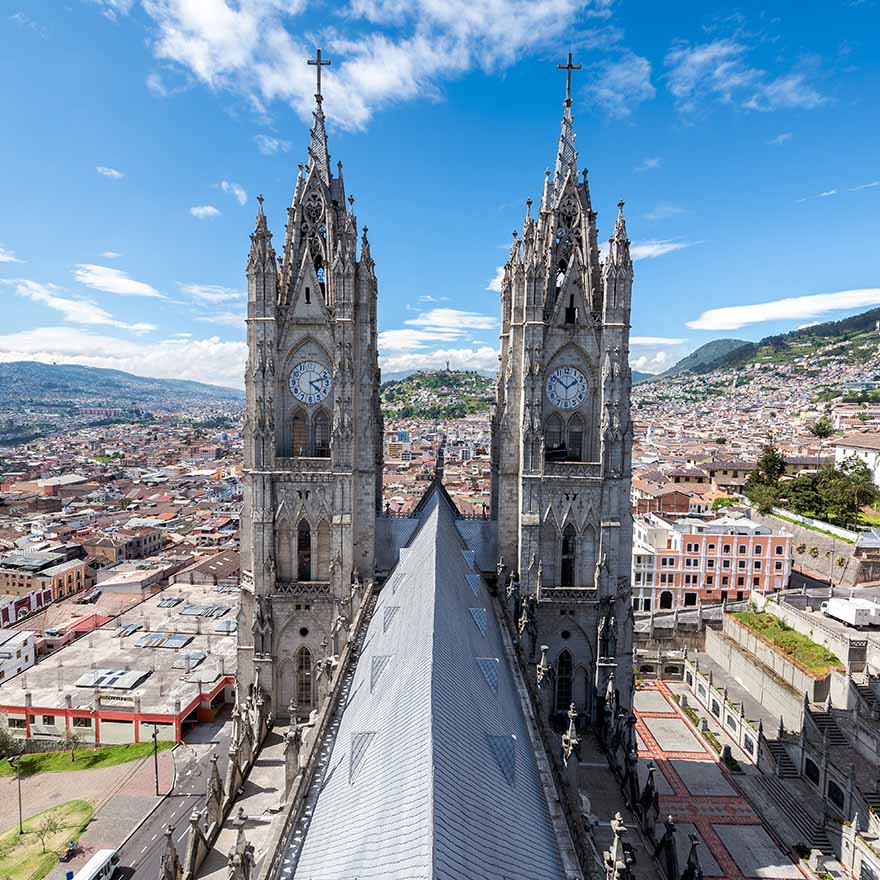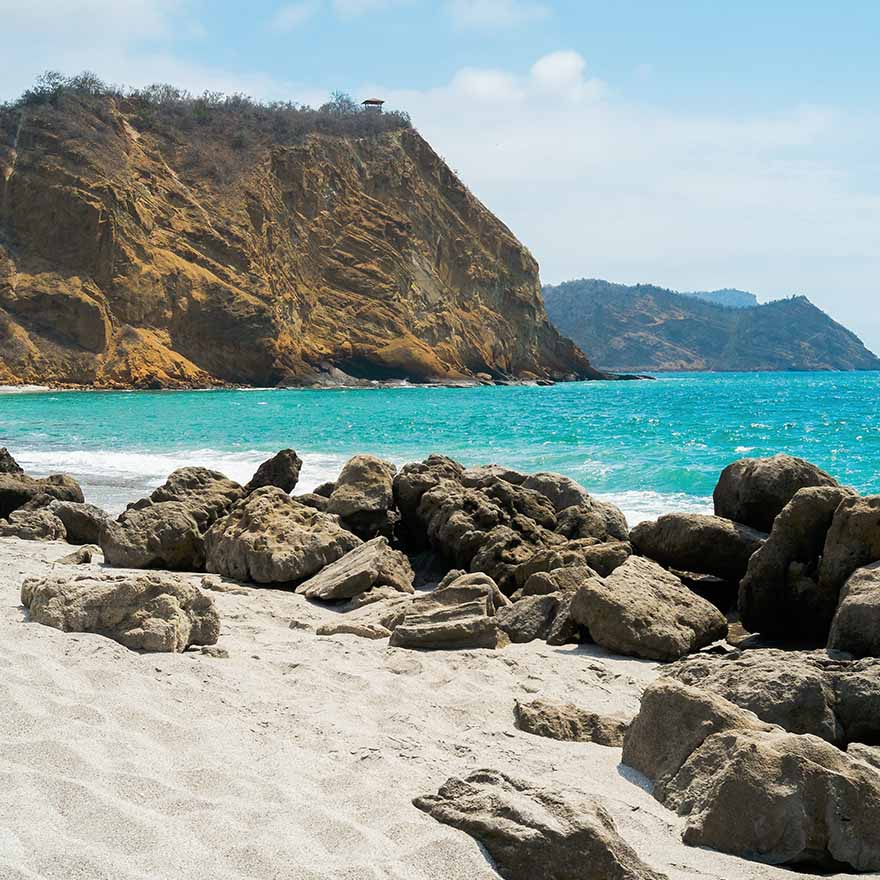Your Cart is Empty
FREE U.S. SHIPPING
Starting from the Pacific Coast, passing the imposing Andes mountain range and the imaginary line that divides the world in half, lies a small paradise called Ecuador. It is difficult to measure and express the cultural, ethnic, climatic and linguistic diversity that exists in a country no bigger than the state of Nevada.
Places to visit in Ecuador are infinite and the Galapagos Islands are without a doubt, the most visited destination. However, there’s much more to do in a country as culturally and naturally diverse as Ecuador.
The heart of the Amazon is shared by all Ecuadorians
One of the regions with the largest indigenous population is the Amazon, known for its extensive forests and biodiversity. So much so that the country has already won Best Green Destination three times in the Word Travel Awards. Moreover, the Amazon holds the title of the most diverse tropical humid forest on the planet awarded to the Yasuní national park. One hectare of this park has the same number of tree species as all the United States and Canada combined.
To let oneself go amidst that fascinating mantle full of vegetation and the mysterious and translucent Napo River, which turns to a surreal orange color at sundown, overwhelms all the senses and organs of the body, including the heart. The Yasuní National Park can only be reached by boat, paddling not to invade a world that seems right out of a fairy tale. Travelling the river is like opening a window to history, a world with 600-year-old trees, endemic species such as the Tiger Heron, the beautiful giant otter and anacondas that can measure up to 6 meters.
One of the best places to have such an experience is the Napo Wildlife Center, an area for observation located in the heart of the park. Here you will find thatched cottages on the shores of the Añangu lagoon. The rhythm of the lagoon, the latent sound of the parrots and the sound of the oars in the water, leave anyone that visits mesmerized.

The mountain range: a tour of the Andes
The Andes are the backbone of Ecuador. They traverse the middle of the country from north to south. With an array of colors, they harbor landscapes that breathe moisture, ice, grass, flames and the famed locro—a hearty thick stew popular along the Andes mountain range.
Quito at dawn, the capital city whose foundation dates back 480 years ago and is a Unesco World Heritage Site, is a surrealist awakening with its lilac, pink and veil of watercolors. The horizon unites a city lit with pastels as well as the Cotopaxi volcano, with its splendid white peak that imposes itself like one protecting a treasure.
Quito is the city of the appetizing butter bread, the baguette, the cinnamon and sesame bread and the famous moncaibas biscuits, better known as "love with hunger ". Among the typical cafes where the city’s most delicious culinary delights can be found are: Café Galletti, Thani Café, Jürguen, Haypan, Pannostro and Krust.
Moreover, Quito is the city of colorful artisan markets, where the finest alpaca ponchos, scarves and many more hand-woven garments are sold. The Handicraft Market of Quito offers everything from straw toquilla hats—famous around the world and better known as Panama Hats—to piercings and even tattoo studios.
Another favorite market is the one found in Otavalo. For all lovers of fine craftsmanship, this is the place for you! There are whole blocks of vivid colors dressed in ancestral fabrics such as wool, cotton and linen.
For an innate mirror of Ecuador’s history and customs there is the famous historical center of Quito. It is considered the most important and best preserved historical complex in Latin America. Just walk through its cobbled streets admiring the beautiful architecture dating from the 16th to the 20th century.
Southwest of Quito is the Quilotoa lagoon, considered one of the most beautiful lakes in the world. It measures 9 kilometers and is inside the crater of the volcano with the same name. Its formation was due to a phenomenon that took place 800 years ago when the volcano collapsed and gave rise to the formation of the lagoon. Here many tourists enjoy taking pictures of the breathtaking scenery.
Further towards the paramo (a high, treeless Andean plateau), the Papallacta lagoon dazzles with its penetrating dark colors. Its water comes from the thaws of the Cayambe and Sarahurco volcanoes, but the view is not all that enchants about this site, as only five minutes away are the Papallacta Hot Springs, a perfect place to relax. These are thermal waters of volcanic origin that reach up to 60 degrees centigrade (140 F) and have natural, healing properties.

The Spondylus Route
This is the hotter Ecuadorian region with beaches that enamor as they go along the Pacific coastline and cover four provinces: Guayas, Santa Elena, Manabí and Esmeraldas. This route is named after the spondylus shell that was used in pre-Columbian times as a currency, an offering for the gods and as a symbol of fertility and rain.
The first stop on this trip is also the most outbound location on the Ecuadorian Pacific coast, called La Chocolatera. It is an impressive lookout, a place where waves crash so hard against rocks and boulders that the sounds and movements remind us of the way chocolate boils. In that magical place where the protagonist is the sea, there are various species of sea lions who brave the waves.
The tour continues on to Ballenita, a quieter and cozier beach. Here it is worth a stop to visit the Dillon Farallon Nautical Museum which, among its exhibits, boasts more than 200 articles from the last century, such as sailing instruments, rudders, submarine doors, as well as some whale bones and sculptures carved in wood.
Travelling along the Ecuadorian Pacific Coast offers adrenaline in the form of extreme sports, such as paragliding in Crucita, where, for only 35 dollars, you can enjoy a must-see view of the ocean and the villages bordering Manabí.

For even bigger adrenaline seekers open sea diving is a great option in a country that houses the largest concentration of giant stingrays in the world! They measure from 5 to 8 meters and come together around Silver Island in the Machalilla National Park, better known as “mini Galapagos”. Moreover, one can see species of animals that are also found in the Galapagos Islands, such as the Puerto Rican Gannet, sea lions, frigates and dolphins.
When thinking about unforgettable sightings, what comes to mind is the unique spectacle that occurs in the months of May, June and July that is the mating of humpback whales. This tour can be done from Santa Elena or Puerto López by boat and has become an icon of Ecuadorian tourism. The saying goes "whales are made and born in Manabí," since whales come here to reproduce and eleven months later they return to give birth on the Ecuadorian coast.
Finally, as not to leave behind the city that recently won the ‘Tourism Oscars’ for best tourist destination in South America, there is beautiful Cuenca. Architecturally speaking it is a museum that comes alive in the midst of modernity. It also reminds us all that Ecuador is a country that is discovered and explored, but never forgotten.
Written by Romina Córdoba Moscoso, who lives and works in Ecuador as a film producer, journalist and photographer. Translated from the original Spanish by Ana Ibrion.